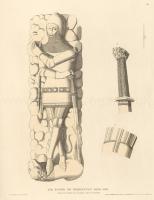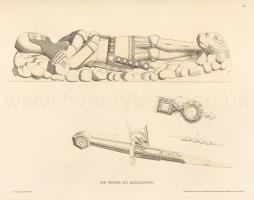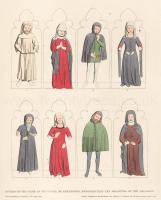Text this colour links to Pages. Text this colour links to Family Trees. Place the mouse over images to see a larger image. Click on paintings to see the painter's Biography Page. Mouse over links for a preview. Move the mouse off the painting or link to close the popup.
Effigy of Sir Roger de Kerdeston is in Monumental Effigies of Great Britain.
THIS monument is in the chancel of Reepham church, Norfolk. The family of Kerdeston held a manor of the same name in Reepham parish as early as the reign of Henry the Third. Sir Roger de Kerdeston died in the 11th year of the reign of Edward III 1337. His military habits are represented by the bed of stones on which he reposes. The male and female figures delineated in Plate III. adorn the base of his tomb. They probably represent his children, or relatives, as mourners, and are most interesting specimens of the costume of the fourteenth century.
Details. Plate 1. Hilt of the sword, genouilliere, and part of the cuisses. Plate II. 1. Side view of the sword-hilt, with part of the belt and scabbard. 2. Agrafe or clasp of the belt. 3. Lace attaching the basinet to the camail. Plate III. Mourners on the base of the tomb.


